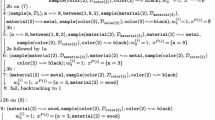Abstract
Qualitative description of the movement of objects can be very important when there are large quantity of data or incomplete information, such as in positioning technologies and movement of robots. We present a first step in the combination of fuzzy qualitative reasoning and quantitative data obtained by human interaction and external devices as GPS, in order to update and correct the qualitative information. We consider a Propositional Dynamic Logic which deals with qualitative velocity and enables us to represent some reasoning tasks about qualitative properties. The use of logic provides a general framework which improves the capacity of reasoning. This way, we can infer additional information by using axioms and the logic apparatus. In this paper we present sound and complete relational dual tableau that can be used for verification of validity of formulas of the logic in question.
Partially supported by projects TIN2006-15455-C03-01 and P6-FQM-02049.
Access this chapter
Tax calculation will be finalised at checkout
Purchases are for personal use only
Preview
Unable to display preview. Download preview PDF.
Similar content being viewed by others
References
Abraham, A., Corchado, E., Corchado, J.M.: Hybrid learning machines. Neurocomputing 72(13-15), 2729–2730 (2009)
Bennett, B., Cohn, A., Wolter, A., Zakharyaschev, M.: Multi-dimensional modal logic as a framework for spatio-temporal reasoning. Applied Intelligence 17(3), 239–251 (2002)
Burrieza, A., Muñoz-Velasco, E., Ojeda-Aciego, M.: A PDL approach for qualitative velocity. Int. J. of Uncertainty, Fuzziness and Knowledge-Based Systems 19(01), 11–26 (2011)
Burrieza, A., Muñoz-Velasco, E., Ojeda-Aciego, M.: Closeness and Distance Relations in Order of Magnitude Qualitative Reasoning via PDL. In: Meseguer, P., Mandow, L., Gasca, R.M. (eds.) CAEPIA 2009. LNCS(LNAI), vol. 5988, pp. 71–80. Springer, Heidelberg (2010)
Burrieza, A., Ojeda-Aciego, M., Orłowska, E.: An implementation of a dual tableaux system for order-of-magnitude qualitative reasoning. International Journal of Computer Mathematics 86, 1852–1866 (2009)
Cohn, A., Renz, J.: Handbook of Knowledge Representation. Elsevier (2007)
Corchado, E., Abraham, A., de Carvalho, A.: Editorial: Hybrid intelligent algorithms and applications. Information Science 180, 2633–2634 (2010)
Corchado, E., Graña, M., Wozniak, M.: New trends and applications on hybrid artificial intelligence systems. Neurocomputing 75(1), 61–63 (2012)
Delafontaine, M., Bogaert, P., Cohn, A.G., Witlox, F., Maeyer, P.D., de Weghe, N.V.: Inferring additional knowledge from QTC N relations. Information Sciences (2011), doi:10.1016/j.ins.2010.12.021
Duckham, M., Lingham, J., Mason, K., Worboys, M.: Qualitative reasoning about consistency in geographic information. Information Sciences 176(6), 601–627 (2006)
Escrig, M.T., Toledo, F.: Qualitative Velocity. In: Escrig, M.T., Toledo, F.J., Golobardes, E. (eds.) CCIA 2002. LNCS (LNAI), vol. 2504, pp. 28–39. Springer, Heidelberg (2002)
Faltings, B.: A symbolic approach to qualitative kinematics. Artificial Intelligence 56(2-3), 139–170 (1992)
Forbus, K., Nielsen, P., Faltings, B.: Qualitative kinematics: A framework. In: Proceedings of the Int. Joint Conference on Artificial Intelligence, pp. 430–437 (1987)
García, S., Fernández, A., Luengo, J., Herrera, F.: Advanced nonparametric tests for multiple comparisons in the design of experiments in computational intelligence and data mining: Experimental analysis of power. Information Sciences 180(10), 2044–2064 (2010)
Golińska-Pilarek, J., Mora, A., Muñoz-Velasco, E.: An ATP of a Relational Proof System for Order of Magnitude Reasoning with Negligibility, Non-closeness and Distance. In: Ho, T.-B., Zhou, Z.-H. (eds.) PRICAI 2008. LNCS (LNAI), vol. 5351, pp. 128–139. Springer, Heidelberg (2008)
Golińska-Pilarek, J., Muñoz-Velasco, E.: Dual tableau for a multimodal logic for order of magnitude qualitative reasoning with bidirectional negligibility. International Journal of Computer Mathematics 86, 1707–1718 (2009)
Hinrichs, T., Forbus, K., de Kleer, J., Yoon, S., Jones, E., Hyland, R., Wilson, J.: Hybrid Qualitative Simulation of Military Operations. In: Proc. Twenty-Third IAAI Conf. (2011)
Liu, W., Li, S., Renz, J.: Combining RCC-8 with qualitative direction calculi: Algorithms and complexity. In: Proceedings of IJCAI 2009, pp. 854–859 (2009)
Liu, H., Brown, D.J., Coghill, G.M.: Fuzzy qualitative robot kinematics. IEEE Transactions on Fuzzy Systems 16(3), 808–822 (2008)
Miene, A., Visser, U., Herzog, O.: Recognition and Prediction of Motion Situations Based on a Qualitative Motion Description. In: Polani, D., Browning, B., Bonarini, A., Yoshida, K. (eds.) RoboCup 2003. LNCS (LNAI), vol. 3020, pp. 77–88. Springer, Heidelberg (2004)
Nielsen, P.: A qualitative approach to rigid body mechanics, University of Illinois at Urbana-Champaign, PhD thesis (1988)
Orłowska, E., Golińska-Pilarek, J.: Dual Tableaux: Foundations, Methodology, Case Studies. Trends in Logic, vol. 36. Springer Science (2011)
Pedrycz, W., Aliev, R.: Logic-oriented neural networks for fuzzy neurocomputing. Neurocomputing 73(1-3), 10–23 (2009)
Randell, D., Cui, Z., Cohn, A.: A spatial logic based on regions and connection. In: Proceedings of KR, pp. 165–176 (1992)
Rasiowa, H., Sikorski, R.: On gentzen theorem. Fund. Mathematicae 48, 57–69 (1960)
Roduit, P., Martinoli, A., Jacot, J.: A quantitative method for comparing trajectories of mobile robots using point distribution models. In: Proc. Intelligent Robots and Systems, IROS 2007, pp. 2441–2448 (2007)
Sokolsky, O., Hong, H.S.: Qualitative modeling of hybrid systems. In: Proc. of the Montreal Workshop (2001), http://www.cis.upenn.edu/~rtg/rtg_papers.html
Stolzenburg, F., Obst, O., Murray, J.: Qualitative Velocity and Ball Interception. In: Jarke, M., Koehler, J., Lakemeyer, G. (eds.) KI 2002. LNCS (LNAI), vol. 2479, pp. 283–298. Springer, Heidelberg (2002)
Tarski, A.: On the calculus of relations. Journal of Symbolic Logic 6, 73–89 (1941)
Van de Weghe, N., Kuijpers, B., Bogaert, P., De Maeyer, P.: A Qualitative Trajectory Calculus and the Composition of Its Relations. In: Rodríguez, M.A., Cruz, I., Levashkin, S., Egenhofer, M. (eds.) GeoS 2005. LNCS, vol. 3799, pp. 60–76. Springer, Heidelberg (2005)
Vries, D., Verheijen, P.J.T., den Dekker, A.J.: Hybrid system modeling and identification of cell biology systems: perspectives and challenges. In: Proc. 15th IFAC Symposium on System Identification, pp. 227–232 (2009)
Author information
Authors and Affiliations
Editor information
Editors and Affiliations
Rights and permissions
Copyright information
© 2012 Springer-Verlag Berlin Heidelberg
About this paper
Cite this paper
Golińska-Pilarek, J., Muñoz-Velasco, E. (2012). Reasoning with Qualitative Velocity: Towards a Hybrid Approach. In: Corchado, E., Snášel, V., Abraham, A., Woźniak, M., Graña, M., Cho, SB. (eds) Hybrid Artificial Intelligent Systems. HAIS 2012. Lecture Notes in Computer Science(), vol 7208. Springer, Berlin, Heidelberg. https://doi.org/10.1007/978-3-642-28942-2_57
Download citation
DOI: https://doi.org/10.1007/978-3-642-28942-2_57
Publisher Name: Springer, Berlin, Heidelberg
Print ISBN: 978-3-642-28941-5
Online ISBN: 978-3-642-28942-2
eBook Packages: Computer ScienceComputer Science (R0)




